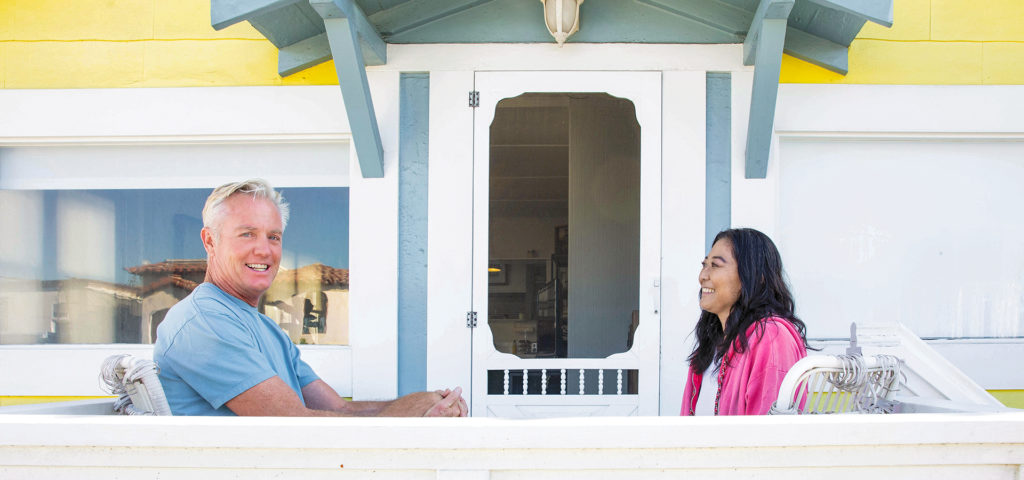
Former Neighbors Christine Schneider and Dan Inskeep Never Knew Their Connection Would Turn out to Be a Lifesaving One
Give & receive.
Hermosa Beach’s Christine Schneider laughs as she reminisces with her neighbor from years ago, Dan Inskeep. Little did they know back then that fate would eventually connect them forever.
Though life has thrown Christine some major blows, she is a fighter and rolls with the punches one at a time. At 16, doctors thought mononucleosis was behind her extreme weakness and fatigue. After she developed a facial rash (referred to as a butterfly rash), she was diagnosed with systemic lupus erythematosus.
Lupus is a chronic autoimmune disease for which there is no cure. It requires lifelong management. With lupus, the immune system mistakenly attacks healthy cells and tissues. Although anyone can get the disease, often through heredity women are more at risk.
“Dan chose to do something selfless, altruistic and out of pure love.”
Christine’s body predominantly attacks her kidneys. At age 30 she received a direct transfer kidney from her brother. A direct transfer means the donor gives the kidney to a specific recipient. Similarly, actress and singer Selena Gomez, who also has lupus, received a direct kidney transplant five years ago from her best friend.
After a successful kidney transplant, lupus symptoms do not present. Typically, a kidney for Christine can last upward of 10 years until her immune system rejects the organ.

In 2014 Christine’s husband, Doug Schneider, died suddenly in a dirt biking accident at just 47 years old. At the same time, it was determined that she needed another kidney. Her former sister-in-law (Doug’s brother’s ex-wife) offered to be her donor.
This past summer Christine found herself in need of another kidney transplant. Finding organ donors is not an easy task, especially when you have already had two transplants. Waiting for a kidney from a cadaver list could also take several years, so having a specific donor is crucial if timing is an issue. If a kidney fails, the patient will need chronic dialysis until the transplant.
Dan Inskeep, also a Hermosa Beach resident, retired 13 years ago at age 48 after working in finance. When asked how he was able to retire so young, he credits a couple of property investments combined with the modest lifestyle he and his wife lead. In fact, while most neighbors are buzzing around town on electric bicycles, Dan proudly rides his old-school beach cruiser, with more rust than silver, over to Christine’s quaint yellow cottage. Confident his bike will not be stolen, he leaves it parked on the sidewalk unattended.
While attending Cal Poly San Luis Obispo, Dan volunteered his time at a local hospital. The hospital assigned him to the dialysis center, where he would sit with patients and have conversations.
“In the early ’80s they only had one tiny television in the corner, and there were 10 to 12 people in the room suffering through hours of dialysis—bored out of their minds,” says Dan. “I was kind of a chatterbox, so they had me talking to these patients. It left an impression on me that, wow, this is horrible.”
Decades later Dan was reminded when a friend donated a kidney to a family member that he also wanted to help dialysis patients. He put his name on the National Kidney Registry. While on the list he learned about Christine’s situation and, after a rigorous screening process, was able to receive a “voucher.” This enabled Christine to not only receive a new kidney but a kidney matched specifically for her body.
“Dan chose to do something selfless, altruistic and out of pure love,” says Christine. “His kidney donation affected multiple people. Not only did it prolong and better his recipient’s life, but it also changed the future for me and Dylan [her 15-year-old son]. I have been blessed with other donors, and each time I’m in awe of the people who give so much of themselves for me. I don’t feel deserving, but I’m so thankful that there are people in this world like him.”
The transplant was considered a success, and Christine was released from the hospital early. Lupus and transplants can be a tricky combination, as introducing a foreign organ into the body could provoke her system to attack the transplant. To counteract a rejection, Christine had to take immunosuppressants.
Not long after the surgery, her hand became extremely swollen and developed an infection—putting her back in the hospital for almost six weeks. To remove the infection, she underwent a couple of surgeries and will be on strong antibiotics for several months.
Christine’s mom, who has been her caretaker during her many health setbacks, is also recovering from a recent stroke that affected one side of her body. Fortunately, Chris Schneider, Doug’s stepmom, stepped in to take Dylan to school and help with meals and errands.
Despite life’s adversities, Christine has a great outlook on life. She knows she must remain strong for Dylan, who put his ice hockey on hold while she recovers. But he is finally ready to get back on the ice, and his mom plans to be there rooting him on.


























